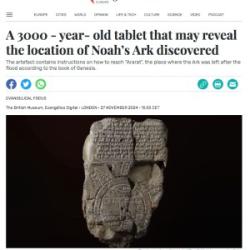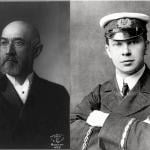• Paul Campos writes, “It should be considered journalistic malpractice to use the phrase ‘Christian nationalism’ and not precede it with the adjective ‘white.'”
This is certainly true here in America, where Christian nationalism in one form or another is older than the nation itself. And every one of those forms of American Christian nationalism — from Bradford to Barton — has involved explicit white nationalism. It has been ever thus, ever since the good Christian Puritans of Massachusetts piously walked past the severed head of Metacomet on their way to church (for 20 years).
Scratch any American form of Christian nationalism and you’ll find white nationalism. And you won’t have to scratch very hard.
Campos wrote that at the end of a profile of longtime Neo-Confederate John Bircher Michael Peroutka, who just secured the Republican nomination as the GOP’s candidate for state Attorney General in Maryland.
• In 1911, President Teddy Roosevelt sent a long-winded letter to the Rev. Franklin Smith, decrying Smith’s advocacy for family planning. Roosevelt wasted a lot of ink on that letter, considering his whole argument could easily have been summed up in 14 words:
“To advocate artificially keeping families small, with its inevitable attendants of pre-natal infanticide, of abortion, with its pandering to self-indulgence, its shirking of duties, and its enervation of character, is quite as immoral as to advocate theft or prostitution, and is even more hurtful in its folly, from the standpoint of the ultimate welfare of the race and the nation. … You say that your ministry lies among well-to-do people; that is, among people of means and upper-class workers. I assume that you regard these people as desirable elements in the state. Can you not see that if they have an insufficient quantity of children, then the increase must come from the less desirable classes?”
Roosevelt also was concerned about how progressive religious journalism was covering his fear of fewer white children being born, complaining: “To me the most horrifying part of this movement is to find nominally religious journals like the Independent containing articles by women and clergymen, apologizing for and defending a theory of conduct which, if adopted, would mean the speedy collapse of this republic and of western civilization. The action of the Independent in this matter was a scandalous offense against good morals and a cause of shame to men of real religious feeling.”
That’s from Rick Pidcock’s Baptist News Global piece, “There’s a straight line from eugenics to ‘biblical family values’ to white supremacy and the anti-abortion movement.”
And it’s not even the ugliest part of the history Pidcock traces. That’s probably the bits he cites from Margaret Farley’s recent discussion of “The Eugenics Roots of Evangelical Family Values.” Here’s a longer chunk of that piece, with Farley’s original links included:
One positive eugenicist who particularly shaped religious conservatives was Californian Paul Popenoe, a central figure in my recent book, The Unfit Heiress: The Tragic Life and Scandalous Sterilization of Ann Cooper Hewitt. Popenoe had been one of the most prolific advocates for the segregation and forced sterilization of people whom he deemed to be “waste humanity,” even inspiring leaders of the Third Reich before the time came for him to rebrand as a defender of patriarchal, procreative marriage. In 1930, Popenoe, an atheist, opened the American Institute of Family Relations (AIFR) in Los Angeles to improve marital harmony and remove what he thought to be obstacles to white reproduction, such as rape, masturbation, pornography, female frigidity, and feminist yearnings. Over the next several decades, Popenoe counseled white couples on the importance of strict gender-norms and same-race marriage, training psychologists, clergymen (many Baptist and Mormon), and youth group leaders—his new allies in the racial betterment project—to do the same. According to Hilde Løvdal Stephens, author of Family Matters: James Dobson and Focus on the Family’s Crusade for the Christian Home, he instructed counselors to use “heredity” and “interpersonal compatibility” as codes for race, especially when his views on race began to go out of vogue.
Popenoe encouraged women to make themselves sexy for their husbands, let domestic violence slide, and look out for their man’s ego and sexual needs. Knowing that some women were sexually reticent, he hired Dr. Arnold Kegel to develop a treatment. (“Kegels” were born.) Popenoe explored methods to suppress homosexual desire, such as electroshock therapy, though it’s not clear if his institute ever used this technology. The man dubbed “Mr. Marriage” also gave considerable attention to clients’ temperaments. One of his first-generation eugenics colleagues, Roswell Johnson, abetted these efforts. Johnson, who’d previously crafted intelligence tests to identify and weed out the “feebleminded,” developed an extensive personality test for assessing compatibility, an adaptation of which is popularly used by Christian marriage experts today.
You thought “purity culture” was just about saving your virginity for marriage? It arose from, and remains deeply entangled with, “securing the existence” of white supremacy.
Pidcock revisits the baby-bust panic that ensued once TPTB realized how small Generation X was compared to its predecessors. The record-breaking baby boom of the Millennial generation didn’t calm those fears any more than it stopped people from pretending that Social Security is going to go “bankrupt.” Hence the current wave of advocacy for breeding our way back to uncontested white supremacy (something Pidcock hears in the natalist cheerleading now coming from Kevin DeYoung, John MacArthur and others).
Roe v. Wade is gone. Buck v. Bell is making a comeback. After all, it is, as Pidcock shows us, “deeply rooted in the history and traditions of the United States.”
• On the subject of white Christian eugenics, I came across the following while reading about the clash between Ida B. Wells and the Women’s Christian Temperance Union. This is Frances Willard, president of the WCTU, in an interview with the New York paper The Voice in 1890: “The colored race multiplies like the locusts of Egypt. The grog shop is its centre of power. The safety of women, of childhood, of the home, is menaced in a thousand localities at this moment, so that men dare not go beyond the sight of their own roof-tree.”
That sure sounds like this Good White Christian lady wanted to eliminate more than just alcohol.
The link above, by the way, goes to an exhibit from the Frances Willard House Museum examining her racist statements and her initial reluctance to speak out against lynching. It’s a good antidote to the white-right freakout du jour about Monticello: “In trying to build a truly national organization only two decades after the Civil War, Willard compromised with white women’s racism. How and why that happened can help us understand the larger story of racism in American women’s movements—and American history in general.”
• CBN, bless their hearts, titled this piece “Witches, Satanists, and Warlocks: Meet the Pastors Who Boldly Shared the Gospel for a Decade in Salem, Mass.”
Translated from the kayfabe, that should read “White evangelical performers answer casting call for tourism industry that fuels local economy.” It seems to have been a win-win for the church-planters, who piggy-backed on the promotional acumen of the town’s new tradition of cashing in on its infamous history. They committed to the bit by, among other things, moving in next door to Salem’s “official witch.”
Sometimes I miss theater.
• The title for this post comes from Martina McBride’s “Independence Day.” It may seem that I’m a few weeks late in posting that song, but I think maybe a song about realizing that the only way to protect your daughter’s life is to burn everything down is pretty much right on time. Here’s McBride singing this with Pat Benatar:
















